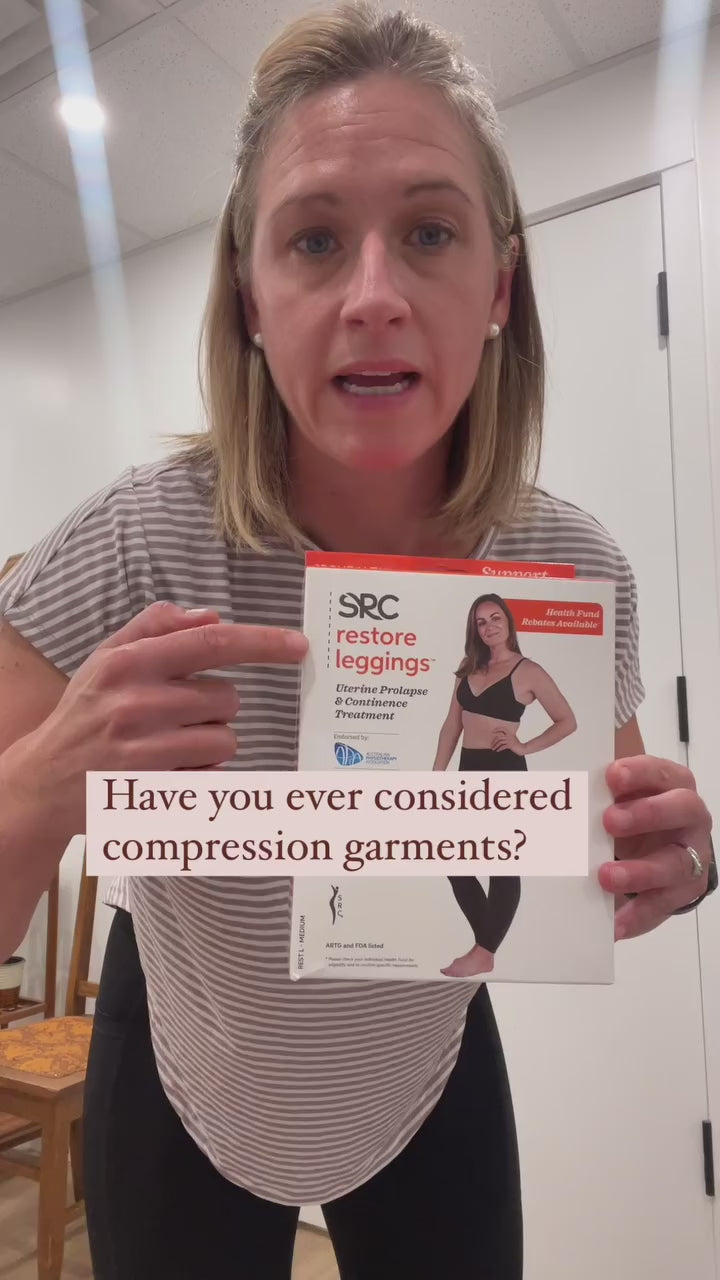What is a Cystocele?
Bladder prolapse, or cystocele, occurs when the front wall of the vagina weakens, causing the bladder to descend into the vaginal canal.
This can lead to a range of uncomfortable symptoms, such as:
- a sensation of fullness or pressure in the pelvis,
- a feeling of sitting on an egg,
- organs slipping out, and
- persistent urinary issues like a constant urge to urinate or a feeling of incomplete emptying.
- Stress urinary incontinence, frequent bladder infections, and pain during sexual intercourse are also common.
If you are experiencing any of these symptoms, you should see your doctor.

Bladder Prolapse Causes:
Bladder prolapse is often caused by significant body stresses, particularly:
- childbirth, which can damage the pelvic floor and vaginal wall.
- menopause also plays a role, as the drop in estrogen levels weakens the muscles that support the bladder.
- other contributing factors include chronic straining from constipation,
- heavy lifting, and
- long-term coughing.
Diagnosis involves a pelvic exam by a gynaecologist or Pelvic Health Physiotherapist, and sometimes imaging tests like x-rays or cystoscopy to rule out other issues and determine the extent of the prolapse.
Treatment options vary based on severity:
- For mild cases, pelvic floor exercises like Kegels can help strengthen the supporting muscles.
- For moderate to severe prolapse, a pessary (an elastic or rigid device that is inserted into the vagina to support the uterus) may be used to hold the bladder in place.
- Estrogen replacement therapy can also help maintain muscle strength.
- SRC Health Restore Compression garments with anatomical support panels can provide continuous compression and symptom relief. The garment has delivered substantial benefits to users as a standalone treatment as well as being successfully used as an addition to other types of pelvic therapies.
- In severe cases, surgery might be necessary, which typically involves securing the bladder in its correct position.
What is a Uterine Prolapse?
Uterine prolapse occurs when the uterus drops into the vaginal canal due to weakened pelvic muscles and ligaments, often resulting from childbirth, aging, or sometimes obesity.
Symptoms include:
- a pulling sensation in the pelvis,
- a bulge of tissue from the vagina,
- urinary incontinence,
- frequent urination, and
- discomfort during sex.
All of the above symptoms warrant a visit to your health care provider of choice, you family doctor, gynaecologist or a women’s pelvic health physiotherapist. Do not wait and put up with discomfort. These symptoms are NOT just something women have to put up with at any age.
The degree of prolapse is classified into four stages, ranging from the uterus being in the upper half of the vagina (Stage I) to it protruding completely outside the vagina (Stage IV).
Risk factors and causes include:
- multiple pregnancies,
- large babies, difficult labour,
- chronic constipation,
- chronic coughing,
- obesity,
- menopause, and
- a family history of weak connective tissue.
Diagnosis typically involves a pelvic exam, and sometimes an MRI to confirm the diagnosis.
For mild to moderate prolapse, treatments include:
- Pelvic floor exercises,
- Pessaries, and
- Estrogen replacement therapy may benefit some women with uterine prolapse as it will assist in strengthening and maintaining muscles in the vagina.
- Severe cases may require surgical intervention to restore normal function and relieve symptoms.
- SRC Health Restore Compression garments, equipped with anatomical support panels, offer continuous compression and symptom relief. These garments have provided significant benefits to users, both as a standalone treatment and as a valuable addition to other types of prolapse treatments.
Preventative measures include:
- regular pelvic floor exercises,
- treating constipation,
- avoiding heavy lifting,
- maintaining a healthy weight and
- the use of SRC compression garments.
SRC Restore, an innovative product, aligns with our “Support for Life” vision and mission. It serves as a follow-on garment to SRC Recovery Shorts.
SRC Restore aids mild to moderate stress urinary leakage and mild to moderate bladder and uterine prolapse with continuous compression to the perineum, which benefits pelvic floor muscle activity. We aim to research further in this area.
SRC Health MD and Founder, Sinead O’Donovan talks to Dr Elaine Barry, Chartered Physiotherapist in Pelvic Health, Bray, Dublin, Ireland about life changing experience of one of her clients.
It does not need to be a mystery, nor should these conditions keep you from being healthy and fit. Thanks to Michelle Kenway, a physiotherapist and internationally renowned author and exercise instructor for women, choosing safe exercises for all types of Pelvic Organ Prolapse has been made easy. Her massively popular YouTube channel, with millions of views, informs women about all things pelvic floor and exercise. There are 2 of her e-books available from our store.
SRC Restore Shorts and Leggings are your perfect incontinence and prolapse exercise companion!

Start living, laughing, and jumping without leaking, and leave that dragging feeling behind. Incontinence and Prolapse exercise-related worsening of these conditions can be avoided.
How do you choose safe exercises, manage your weight, and maintain your fitness if you’ve been diagnosed with either or both?

How can exercise make prolapse worse?
Some forms of exercise can weaken the pelvic floor and worsen a prolapse.
If you have a prolapse you are likely to have weakness in your pelvic floor muscles and supportive tissues.
This makes your pelvic floor more prone to injury since it is less resistant to pressure and strain.
Exercise places downward pressure on the pelvic floor. If the pressure is too great for the pelvic floor to withstand, the pelvic floor muscles become stretched, weak and less able to support your already prolapsed organs. This is how prolapse can become more severe with inappropriate exercise that is not matched to the existing strength of the pelvic floor.
How to Choose Safe Prolapse Exercises?
The key questions to ask when choosing exercise with a prolapse are:
- How much downward pressure and/or strain does your chosen exercise place upon your pelvic floor?
- How strong and well-functioning is your pelvic floor? How well can your pelvic floor provide support to counteract the associated downward pressure?
These following safe exercise selection principles apply to all forms of pelvic prolapse including:
- Uterine prolapse
- Bladder prolapse
- Vaginal wall prolapse (cystocoele/rectocele); and
- Rectal prolapse.
Prolapse and Exercise for Fitness
High impact fitness exercise involves exercises with both feet off the ground at the same time. The impact of landing forcefully increases the downward pressure on the pelvic floor and prolapse.
The pressure of body weight is transferred to the pelvic floor and lower body. This is why prolapse symptoms often feel worse with inappropriate fitness exercises such as running and jumping.
When repeated over extended duration, high impact exercise can progressively stretch and strain the pelvic floor supports.
DONT LOSE HOPE! Once your pelvic floor muscles have regained strength, you can safely return to running and other high-impact exercises.

High impact exercises that may compromise the pelvic floor:
- Running
- Jumping
- Skipping and
- Some dance exercises.
Fitness and weight loss/management exercise can be readily modified to protect the pelvic floor and remain highly effective.
Low impact exercise is the key to reducing impact on the pelvic floor. Low impact exercise is exercise with at least one foot in contact with the ground at all times.
Low impact exercises that are pelvic floor safe include:
- Walking
- Elliptical Cross Trainer
- Road cycle
- Spinning or indoor cycle classes (stay seated and chose low gears)
- Water based exercise
- Low impact fitness classes.
Prolapse and Exercise for Strength and Bone Health
Safe strength training with a prolapse is very feasible, however traditional strength training programs are often designed for men and will usually fail to apply pelvic floor safe strength training principles.
Pelvic floor and prolapse worsening is more likely with:
- Heavy lifting and straining
- Specific strength training exercises; and
- Unsupported positions when lifting (i.e. standing).
Strength exercises that increase pressure on prolapse:
- Wide leg deep squats
- Smith machine squats
- Leg press (seated and incline); and
- Weighted abdominal core strength exercises.
Women seeking pelvic floor safe strength exercises should consult a Pelvic Health Physiotherapist.
Additionally, here’s a complete physical workout in Inside Out Strength DVD workout for women with prolapse, designed and presented by Pelvic Floor Physiotherapist Michelle Kenway.
Core Abdominal Exercise and Prolapse

Scientific research shows that traditional intense core abdominal exercises increase the downward pressure on the pelvic floor and cause descent of the pelvic floor in women with pelvic floor dysfunction.
The risk of injury seems to be increased with these exercises in women with previous vaginal delivery.
Some unsafe core exercises with a prolapse include:
- Sit ups / abdominal crunches (shown right)
- The Plank
- Fit ball or Swiss ball sit ups; and
- Abdominal exercise machines.
Prolapse and Exercise Classes
Some general exercise classes include exercises that may increase the risk of prolapse worsening with increased pelvic floor pressure.
General exercise classes are designed for mainstream, not for women with pelvic floor prolapse. This means that exercises general exercise classes may be unsuitable for prolapse and require modification. The temptation in general exercise classes is often to perform intense and unsuitable exercises with the potential to worsen a prolapse.
Tips for exercise classes and prolapse:
- High impact exercise classes – many of these exercises can be modified to be low impact.
- Strength training/resistance classes can include inappropriate strength exercises and techniques. These can often be modified, or alternative pelvic floor safe strength exercises performed.
- Core training classes-intense core exercises will increase the likelihood of pelvic floor and prolapse strain. Core exercises can also be modified using techniques to reduce the intensity of the exercises on the upper abdominal muscles in particular.
If unsure about any exercise either leave it out or speak with your instructor for alternative exercises. Be mindful of the difficulty of catering to a large number of individuals with wide ranging abilities and expectations with pelvic floor safe exercises in group exercise.
Both bladder and uterine prolapse are common conditions that can significantly impact a woman's quality of life. Diagnosis and treatment are crucial to managing symptoms and preventing further complications.
















